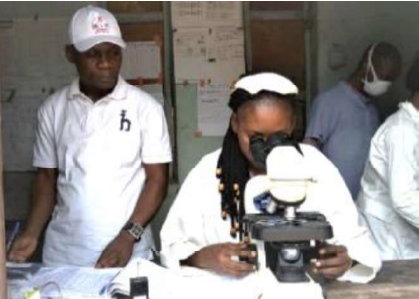- What We Do
- Agriculture and Food Security
- Democracy, Human Rights and Governance
- Economic Growth and Trade
- Education
- Environment and Global Climate Change
- Gender Equality and Women's Empowerment
- Global Health
- Humanitarian Assistance
- Transformation at USAID
- Water and Sanitation
- Working in Crises and Conflict
- U.S. Global Development Lab
Speeches Shim

Five days of contact tracing campaigns led community health workers in the Democratic Republic of Congo to connect 125 new TB patients with treatment and nutritional support.
Multidrug-resistant tuberculosis (MDR-TB) remains a challenge in the Democratic Republic of the Congo (DRC), which has one of the highest rates of the disease globally. Detection rates remain low due to cultural, financial, and geographic accessibility challenges. MDR-TB develops either due to inadequate treatment or direct transmission of MDR-TB strains, with the majority of MDR-TB cases occurring in patients who have never been treated for TB.
In the Sankuru province, where there are frequent MDR-TB outbreaks, only 25 percent of estimated MDR-TB cases were detected in 2018, and only seven percent were detected in the first half of 2019. To address this problem, USAID’s Integrated Health Program (IHP) joined forces with the DRC’s Provincial Committee for Leprosy and Tuberculosis Control (CPLT) to investigate contacts of confirmed MDR-TB cases.
In July 2019, USAID and CPLT organized a mini TB awareness campaign in conjunction with community health workers in Sankuru. This included briefing community health workers on TB protection measures and on strategies for investigating suspected cases and contact cases. At the end of the investigation, community health workers used USAID-provided spittoons to obtain sputum samples and transport them to laboratories for analysis.
This initiative uncovered 96 TB cases, prompting the National Tuberculosis Control Program (PNLT) to ask USAID to expand this strategy to the Dibele, Katako Kombe, and Ototo health zones. That campaign referred 856 presumed subjects to health centers. Of these, 195 tested positive for TB, and 30 tested positive for MDR-TB. Detection rates rose to 85 percent of expected cases, and community health workers connected 125 new patients to medical treatment and nutritional support.
“I was suffering from a cough for more than three months, but I didn’t know it was tuberculosis until the community health worker examined me and confirmed it, said Pala Ekedi, a TB patient. “Now I take medicine, and they even gave me food. I am grateful.”
The Kasai-Central, Kasai-Oriental, and Lomami provinces invited USAID and the Sankuru to share lessons from the successful campaign.
“This MDR-TB outbreak in Bena and Dibele is comparable to Ebola. We urgently needed a response plan to solicit additional support from partners in Sankuru. We are thankful to USAID IHP for their technical and financial support,” said Joseph Bengeya, Deputy Director of the PNLT.

Comment
Make a general inquiry or suggest an improvement.